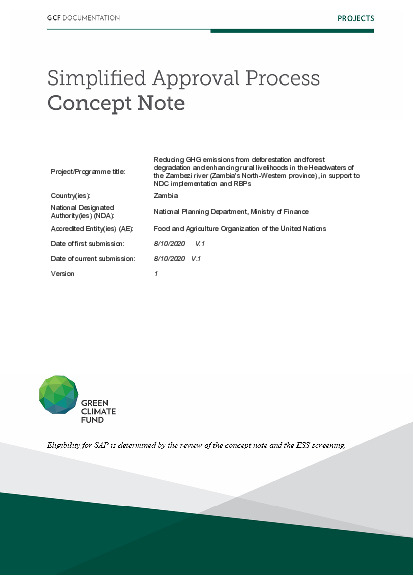Reducing GHG emissions from deforestation and forest degradation and enhancing rural livelihoods in the Headwaters of the Zambezi river (Zambia’s North-Western province), in support to NDC implementation and RBPs

Reducing GHG emissions from deforestation and forest degradation and enhancing rural livelihoods in the Headwaters of the Zambezi river (Zambia’s North-Western province), in support to NDC implementation and RBPs
Deforestation and forest degradation are major concerns in Zambia. The deforestation rate is estimated between 79 000 - 150 000 ha per year (ILUA II, 2016[1]), placing Zambia among the countries with the highest deforestation rate in the world. Deforestation from Land use, land-use change, and forestry (LULUCF) is the main source of greenhouse gases (GHG) emissions, accounting for 73% of total emissions. To address this issue, the Government of Zambia (GoZ) committed through its Nationally Determined Contribution (NDC) to mitigate an estimated 38 million tCO2eq by 2030 from its 2010 baseline and mainstreamed climate change in its Seventh National Development Plan[2] (7 NDP).
Zambia joined the REDD+ mechanism in 2009 as an opportunity to reduce forest-related emissions. The country has made significant progress in complying with REDD+ Warsaw Framework, including the validation of a National Strategy for REDD+, the submission of its Forest Reference Emission Level (FREL) and Safeguards Information System (SIS) to UNFCCC.
However, challenges still persist to effectively achieve emission reductions and access REDD+ Results-Based Payments (RBPs) in a near future. Among others, the FREL needs to be improved notably, to account for forest degradation and gross deforestation activity; The National Forest Monitoring System (NFMS) needs to be operationalized, especially at the provincial level; the SIS needs to be functional; standalone national and subnational REDD+ initiatives need to be streamlined through a national REDD+ nesting system (e.g. REDD+ registry, benefit sharing mechanism, etc.). There are also several barriers to crowding-in and maximizing community and private sector engagement into REDD+ implementation (e.g. up-front investment costs, technology, knowledge, etc.).
This Project seeks to strengthen the REDD+ implementation processes for effective GHG emission reduction from LULUCF and for future access to REDD+ RBP, contributing to fullfiling Zambia's mitigation objectives reflected in its NDC. To this end, the project will (i) support finalization and operationalization of the REDD+ national architecture to facilitate access to RBP, and (ii) support the engagement of local communities and the private sector in REDD+, through sustainable management and enhancement of foret carbon stocks, climate-friendly local livelihoods, and innovative public- private partnerships.
Overall, the Project will contribute to the reduction of GHG emissions of approximately 1.4 million tonnes of CO2 equivalent (tCO2eq) over the Project lifetime at a cost to the GCF of USD 0.14/tCO2eq.
[1] 2016. Integrated Land-Use assessment phase II https://prais.unccd.int/sites/default/files/2018-08/ILUA%20II_Final%20Re...
[2] Seventh national development plan: http://extwprlegs1.fao.org/docs/pdf/zam170109.pdf